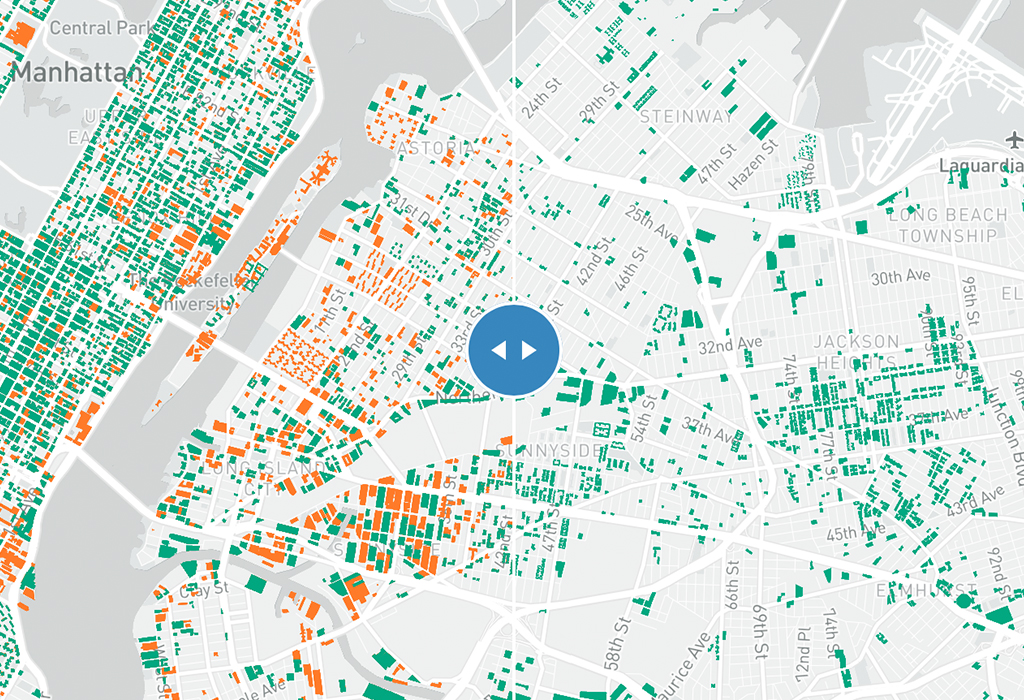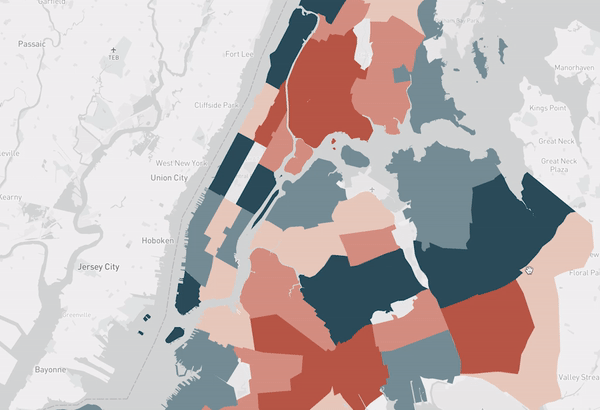Climate Change
One of New York City’s most successful efforts to combat climate change is something that many pedestrians might overlook.
Since 2010, the NYC Department of Environmental Protection has facilitated the creation of more than 1,200 “greened acres,”19 or tracts of land that have been transformed through green infrastructure. These projects take several different forms, the most common being rain gardens. These plots of land are placed in sidewalks throughout the city, and typically contain gravel or crushed rock topped with grasses, shrubs, or native plants.
According to the NYC Department of Design and Construction, a typical rain garden can absorb as much as 2,500 gallons of water during a storm20—no small feat, considering that millions of gallons of polluted water flow into the city’s waterways every year.
New York City’s efforts to mitigate the damaging effects of climate change aren’t limited to rain gardens. In 2019, as part of the Climate Mobilization Act, the City Council approved legislation that requires new buildings to be topped with one of two things: a green roof or solar panels21. As of 2019, there were 730 existing green roofs in New York City, a figure that represents just over 60 acres (out of 40,000 estimated throughout the city).
The Climate Mobilization Act also includes Local Law 97, a law that mandates landlords of buildings larger than 25,000 square feet cap their emissions, in an effort to reduce the city’s greenhouse gas output by 80 percent by 2050. Another piece of the Climate Mobilization Act requires landlords to post energy-efficiency grades on their buildings in an effort to shame property owners into improving their carbon output.
Even something like a protected bike lane helps contribute to the city’s overall climate resiliency by encouraging the use of an eco-friendly method of transportation—cycling—over something like car travel, which is far less green.
But in order for these measures to actually help combat climate change, they must be maintained and funded. For example, a 2019 audit by Comptroller Scott Stringer’s office found that many rain gardens throughout the city are poorly maintained22, to the degree that they would be rendered ineffective. Fewer and fewer street trees have been planted since 2015 for budgetary reasons23. And the Covid-19 crisis threatens the city’s ability to carry out these ongoing projects, as budget cuts loom24.
But the cost of not fighting climate change would be even greater; the future of the city itself is at stake.
Tracking Heat Vulnerability in the City
This data visualization was created by the Civic Data Design Lab.
Cities across the United States are getting hotter, and New York is no different: According to the New York City Panel on Climate Change (NPCC), the average temperature in the city could increase by nearly six degrees by the 2050s25, while the number of days where temperatures top 90 degrees is expected to double. This puts an increasing number of New Yorkers at risk of serious health problems or even death on the hottest days.
New Yorkers are also vulnerable thanks to the urban heat island effect, which can make the city feel more than 20 degrees hotter than its surrounding rural or suburban areas. Because of the way the urban heat island effect works—areas with fewer trees and more asphalt tend to be warmer, for instance—some neighborhoods within the five boroughs are more at-risk than others.
The NYC Department of Health and Mental Hygiene has created a Heat Vulnerability Index (HVI)26, which gives each neighborhood a score based on how likely its residents are to be negatively impacted by extreme heat events; variation among individual neighborhoods is vast. In this visualization, data that affects heat vulnerability—including access to air conditioning, daytime summer surface temperature, and vegetative cover—is mapped alongside other demographic statistics, such as number of households living below the poverty line, to map out which communities are most at-risk. According to this data, the Bronx and Brooklyn have the most people at risk; more than 580,000 residents in the former, and 570,000 residents in the latter, may be harmed by extreme heat.
There’s a distressing correlation between the NYC neighborhoods that are most vulnerable to extreme heat27 and those that were hit hardest by the coronavirus pandemic: areas like the South Bronx, or Corona, Queens, have both high rates of Covid-19 infection, as well as high scores on the Heat Vulnerability Index. This is no coincidence; these areas are home to lower-income residents who are affected disproportionately by systemic racism and the inequities that plague the city.
 Visit Project Devil's in the Data: The Real Pathway to Reducing NYC's Building Emissions This student data visualization was created by Amber Kim, Jordan Owen, Laura Kim at the Massachusetts Institute of Technology in the spring semester of 2020.
Visit Project Devil's in the Data: The Real Pathway to Reducing NYC's Building Emissions This student data visualization was created by Amber Kim, Jordan Owen, Laura Kim at the Massachusetts Institute of Technology in the spring semester of 2020.
To combat this problem, the city allocated $106 million in 2017 to help keep New Yorkers cool through measures like planting more street trees and replacing dark asphalt with lighter, reflective pavement. But it remains unclear if the program will receive more funding in a post-Covid NYC.
Enforcing Local Law 97
In 2019, New York City took a giant step toward reducing greenhouse gas emissions: The City Council passed the Climate Mobilization Act, a package of bills that mandated new emissions standards for thousands of buildings throughout the five boroughs, with the ultimate goal of reducing emissions by 80 percent (from 2005 levels) by 2050.
For building owners, the biggest piece of the legislation is Local Law 97, which requires buildings that are larger than 25,000 square feet to comply with new carbon caps. (Some buildings, such as NYCHA complexes and hospitals, are exempt from the requirements.) This will affect some 50,000 buildings in New York City, and landlords must comply with the new law beginning in 202428.
The legislation is crucial to the city’s efforts to fight climate change because buildings account for 70 percent of New York City’s total greenhouse gas emissions29. According to John Mandyck, the CEO of the nonprofit Urban Green Council, the legislation is “the equivalent of taking almost 1 million cars off the road.”30
To comply with the legislation, building owners will need to retrofit their buildings to be more energy-efficient, using measures like replacing traditional heating systems with electric ones or replacing old windows with new, energy-saving ones.
How these retrofits will be carried out, and how much they will cost, is unclear31. A component of the legislation that would help property owners pay for retrofits has yet to be implemented because of the Covid-19 pandemic. Landlords, meanwhile, are worried about their ability to begin the process of retrofitting their buildings because of coronavirus-related financial hardships32. According to the Mayor’s Office of Sustainability, the total cost of these upgrades to building owners could be as much as $4 billion33.
Another thing that makes this task more difficult is the lack of available data on which buildings must be included. New York City’s Office of Sustainability estimates about 50,000 buildings will be covered, but does not provide an official list of buildings that will be impacted by the law. This visualization attempts to map out the buildings that may be covered by Local Law 97, and the challenges inherent in enforcing the legislation.
References
19. NYC Green Infrastructure, New York City Department of Environmental Protections https://www1.nyc.gov/assets/dep/downloads/pdf/water/stormwater/green-infrastructure/gi-annual-report-2019.pdf
20. 300 New Curbside Rain Gardens in Sunnyside, Maspeth and Ridgewood Will Improve Health of Newtown Creek, New York City Department of Design and Construction https://www1.nyc.gov/site/ddc/about/press-releases/2017/pr-092017-curbside-rain-gardens.page#:~:text=The%20rain%20gardens%20are%20designed,pruning%20the%20trees%20and%20plants.
21. DOB Announces Sustainable Roof Requirements for New Buildings Go Into Affect, New York City Department of Buildings https://www1.nyc.gov/site/buildings/about/pr-sustainable-roof-requirements.page
22. Audit Report on the Department of Environmental Protection's Maintenance of Rain Gardens, New York City Comptroller https://comptroller.nyc.gov/reports/audit-report-on-the-on-the-department-of-environmental-protections-maintenance-of-rain-gardens/
23. More green for less green: NYC tree planting program slows due to rising costs, amNY https://www.amny.com/new-york/more-green-for-less-green-nyc-tree-planting-programs-slows-due-to-rising-costs/
24. Steps to Boost Climate Resiliency Hit by Delays and Cuts, Thanks to COVID-19, City Limits https://citylimits.org/2020/06/18/steps-to-boost-climate-resiliency-hit-by-delays-and-cuts-thanks-to-covid-19/
25. Cool Neighborhoods NYC, The City of New York https://www1.nyc.gov/assets/orr/pdf/Cool_Neighborhoods_NYC_Report.pdf
26. Environment & Health Data Portal, New York City Department of Health http://a816-dohbesp.nyc.gov/IndicatorPublic/VisualizationData.aspx?id=2191,719b87,107,Map,Score,2018
27. New York City Covid Map and Case Count, The New York Times https://www.nytimes.com/interactive/2020/nyregion/new-york-city-coronavirus-cases.html?action=click&module=RelatedLinks&pgtype=Article
28. Council to Vote on Climate Mobilization Act ahead of Earth Day, New York City Council https://council.nyc.gov/press/2019/04/18/1730/
29. Climate Mobilization Act, New York City Council https://council.nyc.gov/data/green/#:~:text=NYC%20Buildings%20and%20Climate%20Change&text=Climate%20change%20is%20primarily%20driven,quarters%20of%20all%20citywide%20emissions.
30. Real Estate Industry Faces Pricey Upgrades From Carbon Emissions Law, The Wall Street Journal https://www.wsj.com/articles/real-estate-industry-faces-pricey-upgrades-from-carbon-emissions-law-11555631023
31. Big Decisions Loom on How NYC Will Implement Historic Carbon-Reduction Law, City Limits https://citylimits.org/2019/10/07/big-decisions-loom-on-how-nyc-will-implement-historic-carbon-reduction-law/
32. Progress and Delays in Putting Milestone Emissions Law into Action, City Limits https://citylimits.org/2020/07/07/progress-and-delays-in-putting-milestone-emissions-law-into-action/
33. Big Buildings Hurt the Climate. New York City Hopes to Change That, The New York Times https://www.nytimes.com/2019/04/17/nyregion/nyc-energy-laws.html
Additional Resources
See more +
See less –















